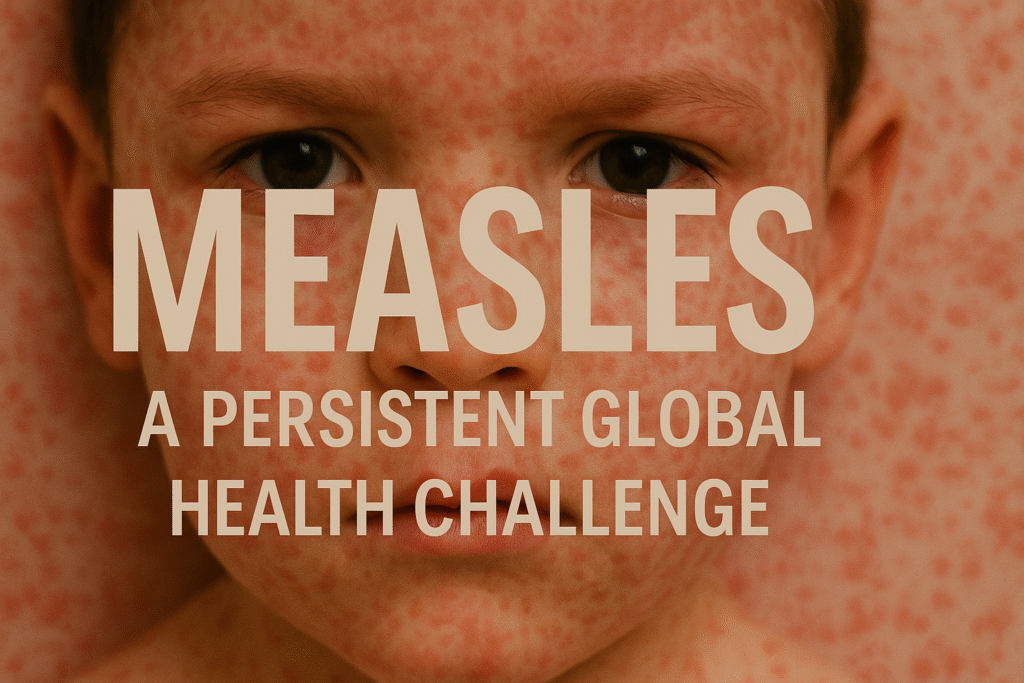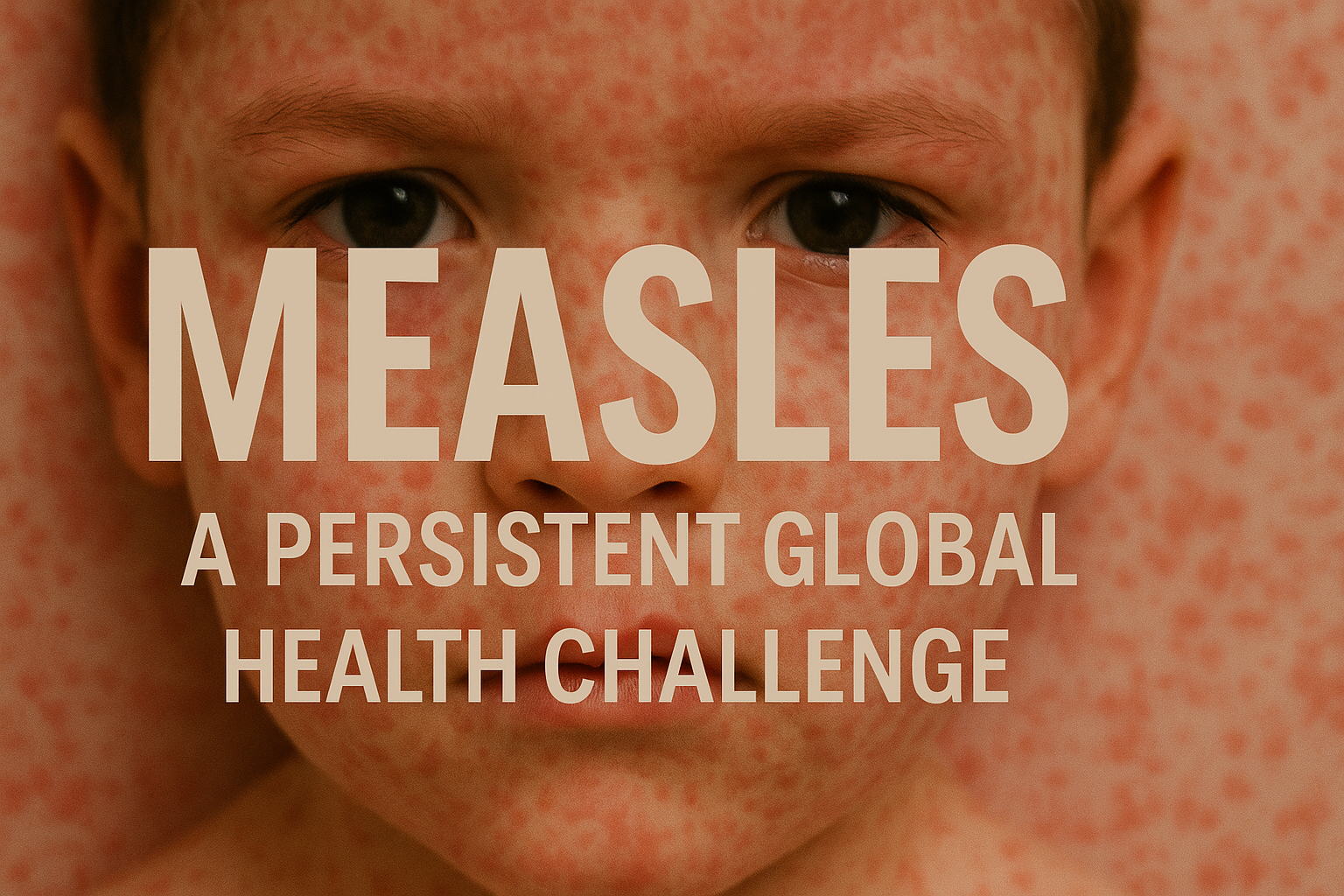Measles, a highly contagious viral disease, remains a significant public health concern despite being preventable through vaccination.
Caused by the measles virus, a member of the paramyxovirus family, it spreads through respiratory droplets from coughing or sneezing.
The disease primarily affects children but can impact individuals of any age who lack immunity. While global vaccination efforts have reduced its prevalence, measles continues to pose risks, particularly in areas with low vaccination coverage.
This article explores the nature of measles, its symptoms, transmission, prevention, and ongoing challenges in eradication.
Understanding Measles
Measles is an acute illness characterized by a distinctive rash, fever, and respiratory symptoms. The virus targets the respiratory system initially before spreading to other parts of the body.
It is one of the most contagious pathogens known, with a single infected person capable of spreading the virus to 90% of non-immune individuals in close proximity.
The virus can remain infectious in the air or on surfaces for up to two hours, making it particularly difficult to control in crowded settings.
The incubation period for measles ranges from 7 to 14 days, during which an infected person may not show symptoms but can still spread the virus.
This silent transmission phase complicates containment efforts, as individuals may unknowingly infect others before realizing they are sick.
Measles is especially dangerous because it can lead to severe complications, particularly in young children, pregnant women, and those with weakened immune systems.
Symptoms and Complications
The disease typically begins with flu-like symptoms, including high fever, cough, runny nose, and conjunctivitis (red, watery eyes).
Within a few days, small white spots known as Koplik’s spots may appear inside the mouth, a hallmark of measles.
These are followed by a characteristic red, blotchy rash that starts on the face and spreads to the rest of the body. The rash usually lasts about a week before fading.
While many recover within two to three weeks, measles can lead to serious complications. Common complications include ear infections and diarrhea, but more severe outcomes include pneumonia, encephalitis (brain inflammation), and, in rare cases, death.
Measles also weakens the immune system, making individuals more susceptible to other infections for weeks or even months after recovery. In developing countries, where access to healthcare is limited, measles-related mortality remains a significant issue.
Transmission and Risk Factors
Measles spreads primarily through respiratory droplets when an infected person coughs, sneezes, or talks. Crowded environments, such as schools or refugee camps, facilitate rapid transmission.
The virus’s ability to linger in the air increases its reach, particularly in poorly ventilated spaces. Unvaccinated individuals, including infants too young to be vaccinated and those who refuse vaccines, are at the highest risk.
Global travel also plays a role in measles outbreaks. An infected person can carry the virus across borders, introducing it to communities with low immunity. This underscores the importance of maintaining high vaccination rates worldwide to prevent resurgence.

Prevention Through Vaccination
The measles vaccine, typically administered as part of the measles-mumps-rubella (MMR) vaccine, is highly effective, providing immunity in about 97% of individuals who receive two doses.
The World Health Organization (WHO) recommends the first dose at 9–12 months of age and the second at 15–18 months. Vaccination not only protects individuals but also contributes to herd immunity, reducing the virus’s ability to spread in a community.
Despite the vaccine’s success, global coverage remains uneven. In 2019, the WHO estimated that 86% of children worldwide received their first dose, but only 71% received the second, falling short of the 95% needed for herd immunity. Vaccine hesitancy, fueled by misinformation, and logistical challenges in low-income regions continue to hinder progress.
Challenges in Eradication
Measles was declared eliminated in the United States in 2000, meaning no continuous transmission occurred for over a year. However, outbreaks have resurged due to declining vaccination rates and imported cases.
Globally, measles cases have risen in recent years, with over 1.2 million cases reported between 2016 and 2019, according to the WHO. Regions with conflict, poverty, or weak healthcare systems face the greatest burden.
Vaccine hesitancy remains a critical barrier. Misinformation about the MMR vaccine, particularly debunked claims linking it to autism, has led some parents to opt out, leaving communities vulnerable. Public health campaigns must counter these myths with clear, evidence-based information to rebuild trust.
Access to vaccines is another challenge. In low-income countries, limited healthcare infrastructure, supply chain issues, and political instability hinder vaccination programs. Efforts to address these barriers include mobile clinics, community outreach, and partnerships with organizations like Gavi, the Vaccine Alliance.
The Path Forward
Eliminating measles requires sustained global commitment. Strengthening routine immunization programs, improving access in underserved areas, and addressing vaccine hesitancy are critical steps.
Public health campaigns should emphasize the vaccine’s safety and efficacy, using trusted community leaders to deliver messages. International cooperation is also essential to ensure vaccines reach remote and conflict-affected regions.
Surveillance systems play a key role in detecting and responding to outbreaks quickly. Rapid response teams can contain outbreaks by vaccinating at-risk populations and isolating cases. Education about early symptoms and the importance of seeking care can further reduce spread.
Conclusion
Measles remains a preventable yet persistent threat to global health. The availability of a safe, effective vaccine offers hope for eradication, but challenges like vaccine hesitancy, unequal access, and global mobility must be addressed.
By prioritizing immunization, countering misinformation, and strengthening healthcare systems, the world can move closer to a measles-free future. Collective action is essential to protect vulnerable populations and ensure this ancient disease no longer claims lives.
